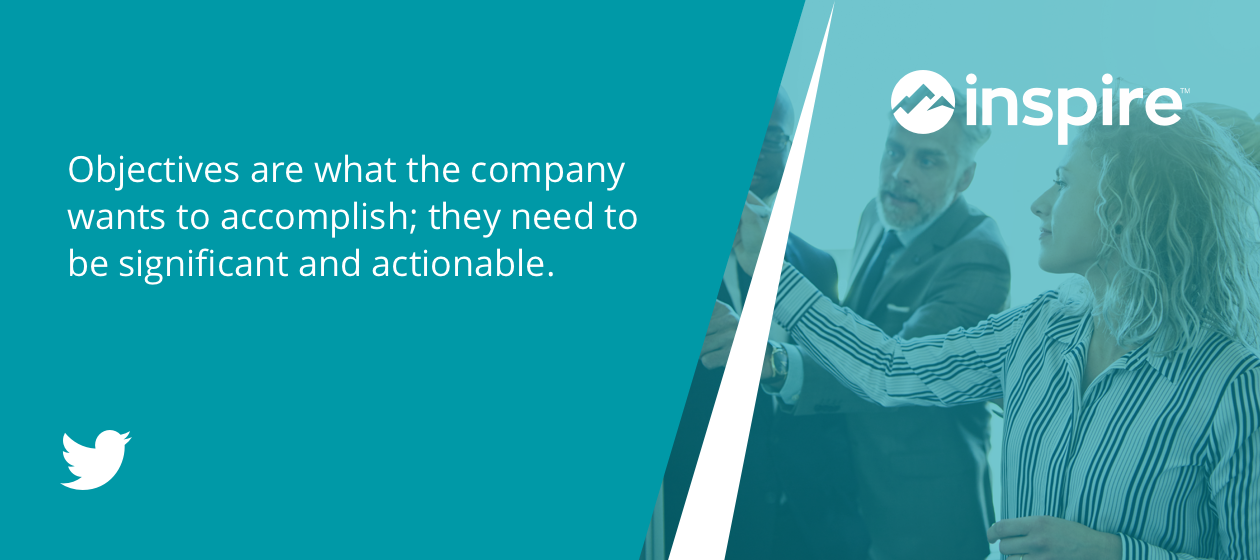Setting and achieving goals can be a difficult task for anyone, even the most successful leaders. Using the Objectives and Key Results (OKRs) method makes achieving goals possible, helps keep the team on track, and ensures conversations and adjustments are effectively made throughout the pursuit of the goal. Top companies such as Google, Facebook, Twitter, LinkedIn, and Uber use OKRs. This method consists of two aspects of a goal: objectives and key results.
Setting and achieving goals can be a difficult task for anyone, even the most successful leaders. See how implementing #OKRs can benefit your company’s goal-setting strategy. @InspireSoftwareTweet This!Objectives are what the company wants to accomplish; they need to be significant and actionable. Key results are a measurable and realistic plan to accomplish the set objectives. To maximize your OKRs, create a realistic number of them; two to five OKRs will ensure you remain focused on what matters most. Key results seek to answer the question: how will objectives be met? OKRs don’t take a lot of time to set up and are simple to execute. Here is why organizational OKRs are the expert goal-setting strategy for your company’s project management:
The What & How of OKRs
OKRs are an effective management tool for organizations. For the company to achieve continual growth, progress needs to be assessed throughout the process to ensure everything is on track toward the objective. It is important for employees to know what is expected of them and how their role and daily activities align with the overall organizational objective. This is what OKRs are designed for; they keep the vision, goals, and objectives of the company, team, and individuals at the forefront of the organization.
OKRs have five main elements:
- Make goals clear—When a goal is not clearly defined, it is hard to know how to achieve it.
- Make goals inspiring—When goals are set high or are part of a bigger picture, employees are inspired to perform better.
- Make goals public—Public goals ensure accountability and employees are more engaged when they can see the whole picture.
- Always measure progress—Regular check-ins with employees and teams are a part of staying engaged with the objective and those collaborating toward the objective.
- Know failure happens—Failure is an inevitable part of setting seeking goals sometimes and you have to know it happens. Having a plan to learn from it, deal with it, and keep moving forward with what is essential.
Benefits of OKRs
OKRs are an effective way to set goals and measure the progress of them.
Once OKRs are set, one-on-one check-ins are essential to the progress of reaching a defined result. Some goal-setting methods are overly complex and cause confusion, rather than working towards success. OKRs, on the other hand, clearly lay out the goals, how to accomplish the goals, and keep the team focused and engaged.
They help employees grow professionally, as well as stay focused in the workplace. They also better align the organization and improve employee engagement. Overall, OKRs motivate employees, increase their productivity, and increase trust with their manager. OKRs also help recognize and celebrate achievements. Whether it be individual or team success, assessing and acknowledging a win encourages employees to thrive at work.
#OKRs are an effective way to set #goals and measure the progress of each. Learn more from @InspireSoftware in this article: Tweet this!How to Succeed with OKRs
Although OKRs may be focused around bigger organizational goals, they make it easy for employees to work towards what’s most important. Once the first most important task is complete, it’s easy for an employee to know where to go next. When each goal is clearly written and understandable, employees know how to accomplish all their job entails. Because OKRs don’t have to be small, individuals and teams are inspired to think big. When your company is filled with ambitious employees, strategy is executed and the company mission is enhanced.
If you’re considering OKRs for your team or organization, become an expert with our latest whitepaper about setting and reaching OKRs through the 5 Phases of Performance. Get your copy here!


